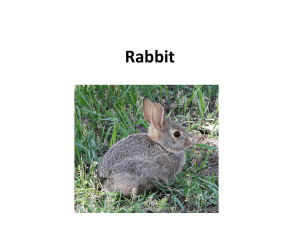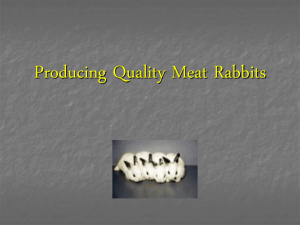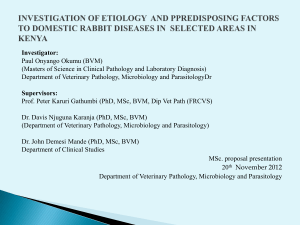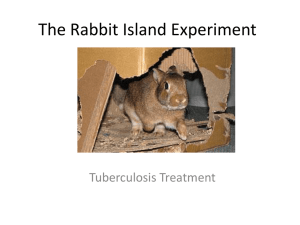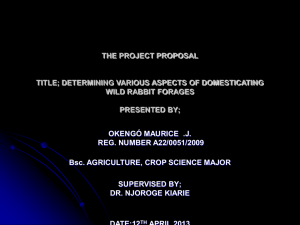Rabbit diseases as a production constraint In Kenya 1
advertisement
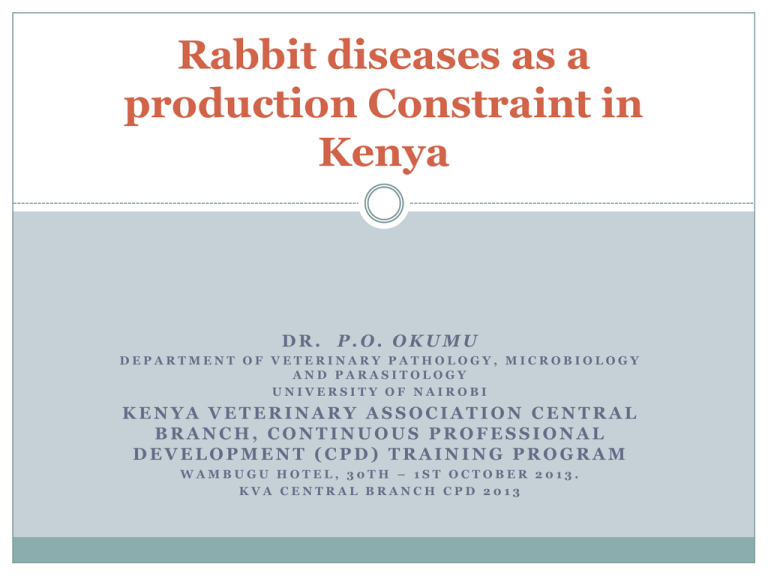
Rabbit diseases as a production Constraint in Kenya DR. P.O. OKUMU DEPARTMENT OF VETERINARY PATHOLOGY, MICROBIOLOGY AND PARASITOLOGY UNIVERSITY OF NAIROBI KENYA VETERINARY ASSOCIATION CENTRAL BRANCH, CONTINUOUS PROFESSIONAL DEVELOPMENT (CPD) TRAINING PROGRAM WAMBUGU HOTEL, 30TH – 1ST OCTOBER 2013. KVA CENTRAL BRANCH CPD 2013 Introduction…. • Rabbit production is now one of the fastest growing livestock enterprises in the world. • Highly prolific, early maturity, fast growth rate, high genetic selection potential, efficiency in feed conversion and economic utilization of space (Lukefahr & Cheek, 1990) • Rabbit meat is white, fine grained, palatable, mild flavored, high in good quality protein content, low fat and caloric contents, contains a higher percent of minerals than other meats Introduction…. Diseases of rabbits in Nairobi have increased tremendously by the year 2010 Aleri et al., (2012) Reasons: Knowledge gap, inadequate connection between field diagnoses and confirmatory laboratory diagnoses (Borter et al., 2010). Introduction…. Limitations (Serem et al, 2012) 51.0% 28.0% 15.5% 11.0% 7.0% 2.8% 4.7% 8.5% 8.7% NOMKT=lack of market both for rabbits and rabbit meat. INADHUSBKN=insufficient knowledge on rabbit husbandry practices, POORBREED=poor breeding stocks, INADFUNDS=lack of funds to expand rabbit enterprises, INADFEED=In adequate commercial feeds in the market, UNKNAHOFF=Animal health officers are un knowledgeable of rabbit diseases and treatment, UNAWARPOP=the Kenyan population is un aware of the benefits of rabbit meat, NOVETDRUG=no veterinary drug specific for rabbits and NOHUTCHPL=lack of proper hutch plans Diseases Gastrointestinal Respiratory Skin Reproductive, Metabolic and nutritional diseases and disorders Miscellaneous conditions. (Martino and Luzi, 2008, Cooper 1973). MATERIAL AND METHODS Visits to sixty one rabbit farms in six counties Questionnaires, post mortem on dead rabbits, laboratory analysis of samples collected and isolation of causative agents. 11.48 Musculoskeletal Respiratory Miscellaneous conditions 27.87 Eye, ears and mouth Skin Gastrointestinal RESULTS 65.57 27.87 22.95 8.2 Disease prevalence by age Gastrointestinal ..conditions Intestinal Coccidiosis Eimeria spps. Clinically: Diarrhea, bloating, nervous signs !just before death, found dead. young rabbits ( from day 21- 3 months) • Prophylaxis-hygiene ??? -Medical- decoquinate, diclazuril, toltrazuril. Treatment - sulphur drugs at 3 weeks for 4 days every 4 weeks till 3 months Vaccination??? Under trial • Intestinal Coccidiosis…… Severe congestion Enteritis Hepatic coccidiosis • Clinically : None to non- specific Anorexia, debilitation, constipation or diarrhea, Pm: Multi-focal whitish yellowish nodules on the liver surface • Control similar to intestinal coccdiosis Mucoid Enteropathy • Multifactorial; bacteria, toxins, dietary irregularity ,obstruction • Common between7-10 weeks also 5-20 weeks • Clinically: bloat, mucoid fecal material, history of change in feed • Treatment: withdraw feed, sulphonamide Control: provide fiber, anti E. coli. in feed (Colimycin, tetracycline, furazolidone) withdraw feed Sulphonamides in water Mucoid Enteropathy Gastric ulcers due to toxins in the feed gelatinous mucoid content in ceacum Bloat • Abdominal distension, diarrhea • Death • Control: - wilt forages Treatment: Not very successful Withdraw feed Give only hay Bacterial conditions • Escherichia coli, clostridiosis and Salmonella spps Clinically: Peracute form: death, with little or no signs. Chronic: anorexia, wasting and intermittent diarrhea over several days. watery green to tarry brown feces; straw colored peritoneal effusion; ecchymoses in the cecal serosa. Bacterial conditions Collibacillosis Control ; hygiene Avoid stress. Extreme cold, high temperatures Treatment: Sulphonamides Multivitamins Pinworms Not very pathogenic May cause obstruction and death when severe Clinically visible in ceacum Treatement: Piperazine fenbendazole Skin conditions • • • • Localized mange Clinically: alopecia, scratching, around the nose, paws Etiology: Sarcoptes scabiei mites Treatment: Avermectin group ( Ivermectin, Doramectin, Selamectin) Control: dusting cages with acaricides Skin conditions Generalised/fur mange Etiology: Cheyletiella parasitovorax (Fur Mites) • Generalized alopecia (dorsal trunk and scapular areas) • loss of condition • Bald patches • Rarely no scratching • Treatment & control: similar sarcoptes Sub-cutaneous abscesses Sub-cutaneous abscesses…. • Etiology: bacterial (Staphylococcus aureus, • • • • Pasteurella spps, Streptococcus spps, Pseudomonas aeroginosa ) Treatment: Draining and cleaning the abscesses Injectible Penicillin, not very suscessful Control : cleaning and disinfection of cages and materials after outbreaks (Omnicide) 800 mg tetracycline HCl (Hydrochloride) per kg feed over a 7-day period have been reported to reduce mortalities temporarily Diseases affecting the eye, ears and mouth Conjuctivitis Ear canker Scabs, crusts, discharges Treatment: Avermectin group ( Ivermectin, Doramectin, Selamectin) Mineral oil ??? temporary Ear canker Encephalitozoonosis (Nosematosis) Etiology: Encephalitozoon cuniculi Clinically: Asymptomatic, nervous signs gross: indented grey areas on the cortical surface Treatment: antiparasitics (fenbendazole, albendazoles) Control: regular disinfection Diseases affecting the respiratory system Pneumonia clinically: chronic snuffles, purulent conjunctivitis, localized abscesses, respiratory difficulty, infertility and sudden death Etiology: Pasteurella,Pseudomonas, Staphylococcus Control: Stress free (cold, weather changes) Good ventilation prophylactic antibiotic therapy & multivitamins Antibiotics: ( suphonamides) early stages. Miscellaneous conditions Splay legs Emaciation Nephritis Trichophagy Cannibalism Fight wounds Splay leg Conclusions • Diseases/conditions which cause morbidity and mortalities in domestic rabbit are those affecting the gastrointestinal, skin and the ears • Enteritis and emaciation are the prevalent conditions affecting domestic rabbits with a prevalence of 29.51% and 14.75% respectively • Coccidia counts per gram of feces were unsatisfactory (> 2000 OPG) in 68% of the farms References • • • • • • • Aleri J W, Abuom T O, Kitaa J M, Kipyegon A N and Mulei C M. (2012).Clinical presentation, treatment and management of some rabbit conditions in nairobi. Bulletin of Animal Health Production in Africa 60: 149 – 152 Borter. K. Daniel, Rosemary N. Mwanza. (2010): Rabbit Production in Kenya, Current Status and way Forward. Nairobi: Animal Production Division, Ministry of Livestock Production: Document Number 1: 1-15 Lukefahr, S. D. And Cheek, P. R. (1990): Rabbit project planning strategies for developing countries. Practical considerations. Livestock Research for Rural Development, Volume 2, Number2, December 1990. Mailu, S.K; Muhammad, L; Wanyoike, M.M and Mwanza, R.N. (2012). Rabbit meat consumption in Kenya: MPRA paper No. 411517, posted 24. September 2012/ 09:46. Online at http://mpra.ub.uni-muenchen.de/41517 Martino P.A, Luzi F. (2008): Bacterial Infections in Rabbit as Companion Animal: A Survey of Diagnostic Samples in Italy. Page1013- 1014.9thWorld Rabbit Congress – June 10-13, 2008 – Verona – Italy Patton NM, Hagen K.W. Gorham J.R., and Flatt R.E. (2008): Domestic Rabbits Diseases and Parasites . PNW 310:19-24. Pakandl, M., Hlásková, L., Poplštein, M., Chromá, V., Vodička, T., Salát, J., & Mucksová, J. (2008). Dependence of the immune response to coccidiosis on the age of rabbit suckling. Parasitology research, 103(6), 1265-127
